High Yield and Bank Loan Outlook - April 2013
While leveraged credit is far from the bargain it was four years ago, discussions of a bubble are premature at this point. Although we have entered the advanced stages of the rally, historical precedent and the continuation of accommodative monetary policy suggest that spreads, particularly those of lower-rated bonds and bank loans, may tighten materially from current levels.
First quarter 2013 returns of 2.9 and 2.4 percent in the high yield bond and bank loan market, respectively, represent the weakest performance to begin a year since 2008. Extended valuations and historically low yields have begun to elicit warnings of a bubble in the high yield market. While leveraged credit is far from the bargain it was four years ago, discussions of a bubble are premature at this point. Although we have entered the advanced stages of the rally, historical precedent and the continuation of accommodative monetary policy suggest that spreads, particularly those of lower-rated credits, may tighten materially from current levels.
With monetary policy mitigating credit risk in the near term, investor focus has shifted to interest rate risk. During the past quarter, rate-sensitive BB bonds underperformed floating-rate single B bank loans by over 100 basis points, a trend we expect to continue. Given the limited supply of net new bank loans, the robust demand from collateralized loan obligations (CLOs) and loan funds should continue to provide a strong technical bid. In the bond market, we remain focused on identifying select opportunities in upper middle-market tranches, where there is a greater ability to drive outcomes.
REPORT HIGHLIGHTS:
- The typical credit cycle, following a recession, lasts approximately 60 months with spreads not beginning to widen until the 80th month. Discussions of a bubble may be early, considering that the current credit rally will just be entering its 46th month post-recession in April 2013.
- Concerns of a sudden shift in monetary policy derailing the credit rally appear largely unfounded. The Federal Reserve has given no indication of plans to begin normalizing accommodation or tightening until 2015, at the earliest. Additionally, historical precedent shows that, in four out of the last five credit rallies, spreads continued to tighten even after the Fed began raising rates.
- Retail demand for bank loans remains robust as investors seek to minimize interest rate risk. Dating back to last year, loan funds have registered 31 consecutive weeks of positive inflows through March 2013. Year-to-date inflows of approximately $13 billion have already exceeded the total for full year 2012.
- The resurgence of the CLO market has contributed to the rise in loan issuance during the first quarter of 2013. Bank loan issuance totaled $150 billion in the first three months of this year, a level not reached until August last year. 64 percent of this year’s issuance has been used for refinancings, resulting in lower spreads and all-in yields.
Leveraged Credit Scorecard as of month end

Source: Credit Suisse. Excludes split B high yield bonds and bank loans.
*Discount margin to maturity assumes three-year average life.
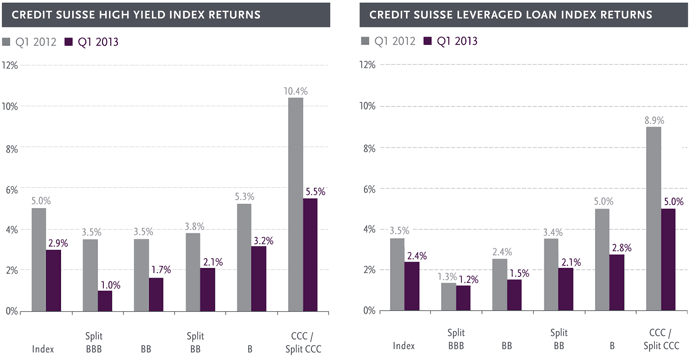
Source: Credit Suisse. Data as of 03/31/2013.
Macroeconomic Overview
STRENGTH OF HOUSING AND EMPLOYMENT SHIFTS FOCUS FROM FUNDAMENTALS TO POLICY
Macroeconomic Factors: Housing and Employment Providing Strong Tailwinds
The U.S. expansion is unlikely to be derailed given the strength of housing and employment. The recovery in employment tends to be understated due to the sheer magnitude of the drawdown at the height of the financial crisis and continued softness in the public sector. In the private sector, the U.S. economy is currently adding an average of 175,000 jobs per month since March 2010, a rate that is over 20 percent higher than that of the prior expansion. Turning to housing, January and February 2013 marked the best two-month period of new home sales since 2008. Given the low levels of existing home inventory, housing starts should continue to rise, providing a boon to construction employment. Additionally, with home values reaching their highest levels since 2007, this should drive increased consumption. Housing tends to be the largest asset on the balance sheets of American households and unlike rising stock portfolios, home appreciation is generally viewed as a more permanent source of wealth.
Monetary Backdrop: Normalization vs. Tightening
As the economy powers along, economic risk has been replaced by growing event and policy risk. Recent rumblings regarding the inevitable normalization of monetary policy have created concern that a sudden policy shift could derail the credit rally. The market is failing to distinguish between normalization and tightening. Tightening refers to the Fed raising interest rates with the intended purpose of restricting economic activity to prevent overheating. Removing accommodation, or normalization, is not the same as tightening. While this is a very important distinction, the bottom line remains that we are still a long ways away from either. More importantly, Fed tightening has historically been viewed as a positive for the broader economy since it signals the anticipation of sustained growth. Following the previous five periods of extended monetary accommodation, credit spreads continued to tighten after the first Fed rate hike on four occasions.
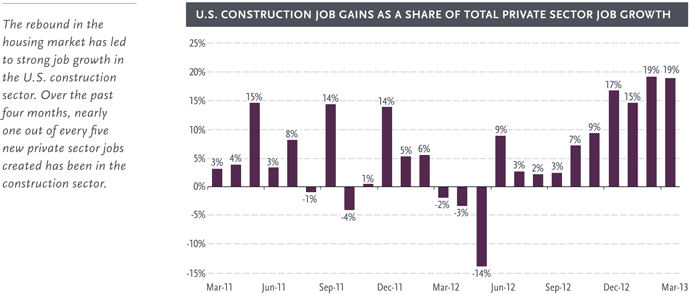
Source: Bloomberg, Guggenheim Investments. Data as of 03/31/2013.
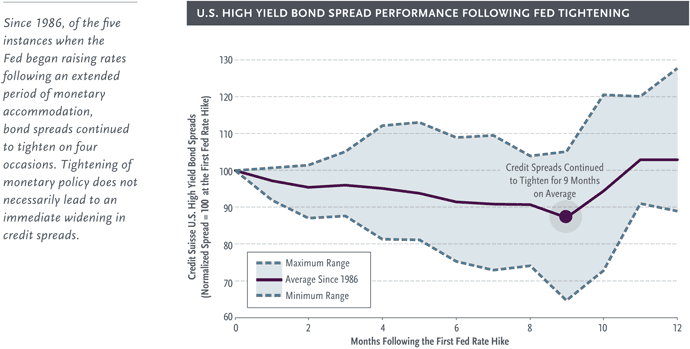
Source: Credit Suisse, Bloomberg, Guggenheim Investments. Data as of 03/31/2013. The range is generated by calculating the maximum and minimum values for all five previous cycles.
Investment Implications: Following the 2004 Script
Piecing together current market sentiment with the macroeconomic and monetary backdrop, present conditions appear very similar to those of 2004. Back in 2004, the economy was entering its third year of expansion following the recession of 2001. At the time, skeptics questioned the ‘jobless recovery’, but as market confidence grew, risk assets continued their ascent with high yield bonds and equities rising 17 and 28 percent, respectively, over the subsequent three-year period. As we would later find out, this period would also prove to be the formative years of asset bubbles, most notably in housing. While we believe the market will follow a similar script over the next three years, the credit market is not currently exhibiting the traditional characteristics of a bubble.
It is important to make a clear distinction between an overvalued market and an asset bubble. While overvalued markets have lost much of the fundamental cheapness that provided a cushion against market noise and pullbacks, they can remain overvalued for an extended period of time. These periods are generally referred to as bull markets. An asset bubble, on the other hand, represents a market reaching unjustifiably high valuations that have never been seen before. Given that bond spreads are still 200 basis points wide of all-time tights and we are likely to remain in a period of low defaults for the next several years, we are not in a bubble yet but the chances of one forming increases the longer the Fed maintains its accommodative policies. Amid stretched valuations and lower margins of safety, investors need to be alert to a sudden reversal of fortunes in the market. In the following sections, we describe how investors can position their leveraged credit portfolios in an effort to safeguard against future risks.
Q1 2013 Leveraged Credit Recap: Key Insights
RATE RISK BECOMING A LOOMING CONCERN FOR INVESTORS
- Last year, the strong performance of the new issue market was one of the primary drivers of the sector’s success. In a trend that began during the latter half of 2012, aggressive new issue bond pricing has begun to minimize investor upside. During the first quarter, high yield bonds returned 2.9 percent, the lowest first quarter return since the end of the financial crisis.
- The trend of favorable new issue deal terms for issuers has been prevalent on the loan side as well, but to a lesser extent. In select instances, investors have been able to push back against increasingly aggressive deal structures and pricings. During the quarter, 22 deals were pulled, representing $16 billion in proposed proceeds. For the quarter, bank loans returned 2.4 percent, driven by strong institutional and retail demand.
- Reinvestment risk has become a serious concern for bank loan investors due to the wave of refinancings. During the quarter, the sector saw $95 billion of refinancings, which on average, lowered spreads by 90 basis points. The dearth of net new supply has compelled many investors to participate in these transactions, resulting in lower spreads and weaker call protection.
- With monetary policy largely neutralizing credit risk, interest rate risk has taken precedence. Over the past three months, floating-rate single B bank loans outperformed BB bonds by over 100 basis points. Additionally, we saw the long beta trade come back into favor as CCC bonds outperformed BB bonds by 375 basis points during the quarter.
- We continue to see superior relative value in lower-rated, upper middle-market financings ($300 - $750 million). Leveraging our private debt platform, our deep relationships with these issuers have provided greater opportunities to offer guidance on deal structure and pricing levels.
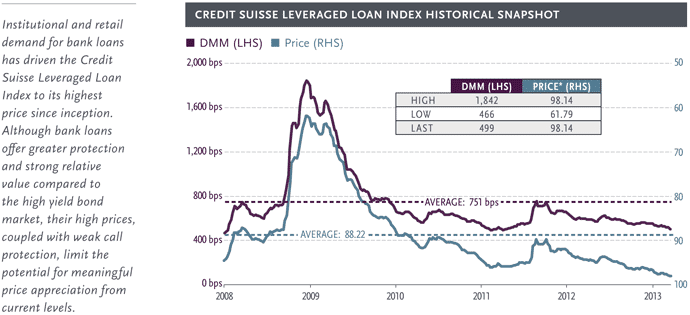
Source: Credit Suisse. Data as of 03/31/2013. *Note: price is inverted on secondary y-axis.
Increasing Attractiveness of Bank Loans
DEMAND OUTSTRIPPING SUPPLY CREATES STRONG TECHNICAL DYNAMIC
The increased protection of bank loans, in the form of floating-rate coupons, secured status, seniority in the capital structure and maintenance covenants, has traditionally come at a considerable yield discount to high yield bonds. In recent years, this yield discount has narrowed with the Credit Suisse Leveraged Loan Index currently yielding just 45 basis points less than the Credit Suisse High Yield Index, compared to the historical average of 160 basis points. The burgeoning relative value of bank loans has attracted strong retail flows into the sector, presumably at the expense of high yield bonds. During the first quarter, the loan market enjoyed inflows of $13 billion, compared to inflows into bond funds of approximately $1 billion. Retail investors, however, represent less than 25 percent of the high yield bond and bank loan market and tend to be less ‘sticky’ than institutional capital. The more noteworthy development has been the reemergence of the CLO market. CLOs, which represent 60 percent of the buying base, are projected to finish 2013 with full-year issuance of $70 billion, eclipsing last year’s total of $55 billion.
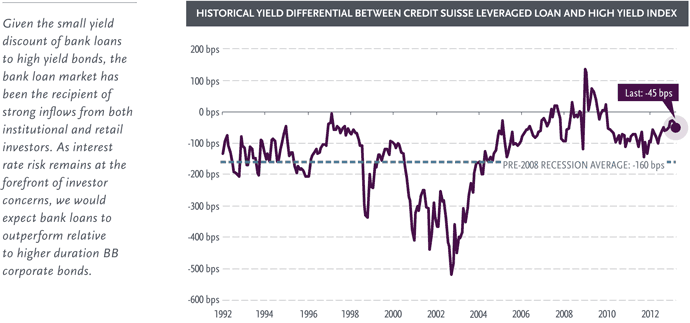
Source: Credit Suisse. Data as of 03/31/2013.
Corporations have capitalized on the strong risk appetite to issue $150 billion in bank loans during the first quarter. Due to the high level of refinancing activity, this has resulted in limited incremental net new supply and has been easily absorbed by the market. 64 percent of total issuance went towards refinancing activity, compared to 14 percent for leveraged buyouts (LBOs). Based on attractive equity valuations and cheap debt financing, we do anticipate LBO activity picking up over the course of the year, however, to this point, it has yet to materially add new supply to the bank loan market. Of the $51 billion in LBO volume during the first quarter, a single transaction, H.J. Heinz, represented over half of the total. The dearth in diversity and volume of new leveraged loans has forced many investors to accept lower spreads in refinancing transactions.
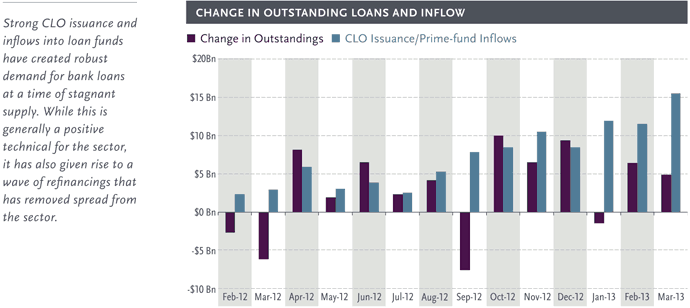
Source: S&P Capital IQ LCD, Lipper, EPFR. Data as of 03/31/2013.
The massive imbalance between demand and supply underscores our constructive view on the bank loan market. Factoring in loan redemptions and prepayments, the total size of the U.S. leveraged loan market has increased by less than two percent since the end of 2012. However, this positive technical is tempered by lower forward return forecasts. Refinancings are removing an average of 90 basis points of spread on each deal, while lenders are increasingly being forced to accept call protection of just six months compared to the standard 12 months.
Optimal Portfolio Positioning
TRANSITIONING FROM OFFENSE TO DEFENSE
As the Fed continues to engineer an environment of ample liquidity, resulting in low defaults, it remains an optimal time to take prudent credit risk. While we believe the leveraged credit sector has more room to the upside, there is one important caveat. Extended valuations have made high yield bonds more susceptible to increased volatility. The slightest geopolitical provocation may give rise to a correction as investors seek to consolidate gains in the high yield market. After realizing annualized returns of 11 percent over the past five years, nearly double that of the equity markets, we sit in a markedly different place in the credit cycle today than we did in 2008 when assets were so fundamentally cheap that investors operated with a much wider margin of safety.
Due to their premium prices and stretched valuations, it is unlikely that high yield bonds will continue to provide equity-like returns, in the near term. Recent market behavior has begun to reflect this sentiment as investors have begun transitioning from offense to defense through increased allocations to bank loans. Lower rated, upper middle-market bank loans offer comparable yields to BB bonds but provide a much greater degree of comfort, in the event of rising rates and deteriorating credit quality. For investors seeking to participate in the credit rally while remaining protected on the downside, bank loans are the investment vehicles best positioned to provide this flexibility.

Source: Bloomberg, Credit Suisse. Trailing returns as of 03/31/2013. Annualized returns for 3yr, 5yr and 10yr.
IMPORTANT NOTICES AND DISCLOSURES
Past performance is not indicative of future results. There is neither representation nor warranty as to the current accuracy or, nor liability for, decisions based on such information. This article is distributed for informational purposes only and should not be considered as investment advice, a recommendation of any particular security, strategy or investment product or as an offer of solicitation with respect to the purchase or sale of any investment. This article should not be considered research nor is the article intended to provide a sufficient basis on which to make an investment decision. The article contains opinions of the author but not necessarily those of Guggenheim Partners, LLC its subsidiaries or its affiliates. The author’s opinions are subject to change without notice. Forward looking statements, estimates, and certain information contained herein are based upon proprietary and non-proprietary research and other sources. Information contained herein has been obtained from sources believed to be reliable but is not guaranteed as to accuracy. This article may be provided to certain investors by FINRA licensed broker-dealers affiliated with Guggenheim Partners. Such broker-dealers may have positions in financial instruments mentioned in the article, may have acquired such positions at prices no longer available, and may make recommendations different from or adverse to the interests of the recipient. The value of any financial instruments or markets mentioned in the article can fall as well as rise. Securities mentioned are for illustrative purposes only and are neither a recommendation nor an endorsement. Individuals and institutions outside of the United States are subject to securities and tax regulations within their applicable jurisdictions and should consult with their advisors as appropriate. No part of this article may be reproduced in any form, or referred to in any other publication, without express written permission of Guggenheim Partners, LLC. ©2013, Guggenheim Partners, LLC.
Copyright © Guggenheim Partners











